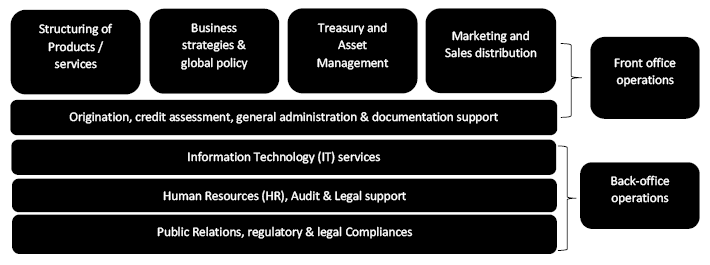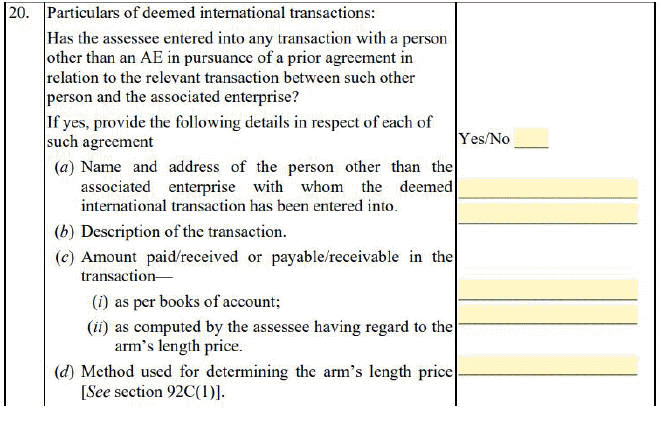The post [Opinion] Expanding Safe Harbour Rules to Restrain Transfer Pricing Disputes appeared first on Taxmann Blog.
]]>
Rajiv Bhutani – [2025] 172 taxmann.com 770 (Article)
In the Indian tax landscape, Transfer Pricing has always been the most sought-after scrutinised area of the Indian Revenue Authorities. With no straitjacket formulae and related-party transactions under the microscope, such Transfer Pricing scrutiny audits generally conclude at very high-pitched inverse additions.
While the subjectivity surrounding the pricing of related-party transactions remains a constant battle to be fought between taxpayers and Indian Revenue Authorities, the Indian Transfer Pricing law has come a long way to make it more inclusive for the taxpayers. In addition to offering the traditional appellate forums to the taxpayers, the Indian Government has introduced various taxpayer-friendly measures over the years.
Establishing a Dispute Resolution Panel as an alternative way to the Commissioner Appeals route for lodging objections against negative Transfer Pricing audits was a welcome step taken by the Indian Government many years ago. The introduction of the Advance Pricing Agreements (APA) regime in India has been considered as the most successful step taken towards removing ambiguity around the pricing of related-party transactions and achieving tax certainty. Even the amendments to the Mutual Agreement Procedure (MAP) rules a few years ago have been helping taxpayers resolve their prior cross-border disputes in a faster and efficient manner.
Among such successful and taxpayer-friendly measures, the introduction of Safe Harbour rules has been no less than a blessing to taxpayers entering cross-border transactions with their multinational group entities. The Safe Harbour rules not only help in avoiding discrepancies in related-party transaction pricing but also provide much-needed tax certainty for a certain class of related-party transactions.
What are the Safe Harbour rules?
As the name suggests, opting for Safe Harbour rules lands the taxpayer in a safe harbour. Safe harbour was defined to mean circumstances in which the Indian Revenue Authorities shall accept the Transfer Price declared by a taxpayer. The rules prescribe specified related-party transactions/covered transactions and the corresponding pre-defined rates/ Safe Harbour rate along with the thresholds for taxpayers, which makes a taxpayer eligible to opt out of such rules.
Click Here To Read The Full Article
The post [Opinion] Expanding Safe Harbour Rules to Restrain Transfer Pricing Disputes appeared first on Taxmann Blog.
]]>The post Sec. 271AA Penalty Could Not Be Levied if AO Failed to Provide Details Regarding Docs. Not Submitted Before TPO | ITAT appeared first on Taxmann Blog.
]]>
Case Details: DCIT v. Priya Blue Industries (P.) Ltd - [2025] 171 taxmann.com 177 (Ahmedabad-Trib.)
Judiciary and Counsel Details
- T.R. Senthil Kumar, Judicial Member & Narendra Prasad Sinha, Accountant Member
-
Tushar Hemani, Sr. Adv. & Parimalsinh B. Parmar, A.Rs. for the Appellant.
-
Rignesh Das, Sr. D.R. for the Respondent.
Facts of the Case
Assessee company was engaged in the business of Ship Breaking, Recycling and Sale of Scrapes. While passing the order under section 92CA(3), the Transfer Pricing Officer (TPO) accepted the transactions in relation to the vessel purchase to be at Arm’s Length Pricing (ALP). Therefore, no adjustments were made with respect to the transaction.
However, the TPO made adjustments regarding other transactions entered into by the assessee. The Assessing Officer (AO) levied a penalty on the alleged ground that the assessee failed to maintain documents specified under section 92D read with Rule 10D.
On appeal, the CIT(A) deleted the penalties. The matter reached before the Tribunal.
ITAT Held
The Tribunal held that the AO levied the penalty under section 271AA for all the assessment years with regard to the purchase of vessels made with the associated enterprise (AE). In the Penalty Order, the AO simply observed that the assessee had committed the default within the meaning of section 271AA. Thus, the AO levied the penalty without pointing out which of the documents prescribed under section 92D r.w.r. 10D have not been maintained by the assessee.
It is seen that the TPO passed the order under section 92CA, wherein he made two TP adjustments unconnected with purchase transactions of vessels made with AE. Thus, the TPO did not doubt such purchase price nor made any upward adjustments relating to purchase transactions with AE, which means that such transactions are recorded at arms-length price.
It is further seen that such transactions are also mentioned in Form 3CEB filed before the date of the search. The AO did not doubt such purchase value in the final assessment order. The Tribunal in various cases held that penalty under section 271AA cannot be levied without specifying the required documents failed to be maintained/furnished by the assessee. Thus, the issue is no more res-integra.
Further, it is noticed that the penalty order was passed in a perfunctory manner without giving a requisite show-cause notice and without affording a proper opportunity of hearing to the assessee. Moreover, the AO had merely show caused the assessee to file details/documents maintained as per rule 10D of Income-tax Rules, without specifying any particular clause itself. Thus, there is no merit in levying penalty holding that the assessee has not maintained proper documents.
List of Cases Referred to
- Dy. CIT v. Indian Additives Express High Way [2017] 88 taxmann.com 954 (Chennai – Trib.) (para 7)
- Asstt. CIT v. Smith & Newphew Healthcare (P.) Ltd. [2011] 16 taxmann.com 5/48 SOT 607 (Mumbai) (para 7)
- Dy. CIT v. Bebo Technologies (P.) Ltd. [2013] 40 taxmann.com 168/[2014] 148 ITD 122 (Chandigarh – Trib.) (para 7)
- Dy. CIT v. Convergys Customer Management Group Inc. [2022] 143 taxmann.com 43/[2023] 198 ITD 100 (Delhi – Trib.) (para 7.1)
- ITO (OSD) v. PPN Power Generating Co. (P.) Ltd. [2012] 18 taxmann.com 127/50 SOT 26 (Chennai) (para 7.1)
- Asstt. CIT v. Global One India (P.) Ltd. [2012] 19 taxmann.com 249/53 SOT 106 (Delhi) (para 7.1)
- CIT v. Leroy Somer & Controls (India) (P.) Ltd. [2013] 37 taxmann.com 407/218 Taxman 216/[2014] 360 ITR 532 (Delhi) (para 7.1)
- Tapi JWil JV v. ITO [2024] 158 taxmann.com 433 (Delhi – Trib.) (para 7.1)
- Apace Realty v. ITO [2022] 140 taxmann.com 257 (Mumbai – Trib.) (para 7.1)
- Dy. CIT v. Francois Compressors India (P.) Ltd. [2021] 129 taxmann.com 260 (Pune – Trib.) (para 7.1)
- DCIT v. Bebo Technologies Pvt. Ltd 40 Taxman 160 (para 8.3).
The post Sec. 271AA Penalty Could Not Be Levied if AO Failed to Provide Details Regarding Docs. Not Submitted Before TPO | ITAT appeared first on Taxmann Blog.
]]>The post Sec. 92BA Applies to All Assessees Regardless of Section 80-IA Deduction Is Claimed | ITAT appeared first on Taxmann Blog.
]]>
Case Details: Sanghi Industries Ltd. vs. Deputy Commissioner of Income-tax - [2025] 170 taxmann.com 716 (Hyderabad-Trib.)
Judiciary and Counsel Details
- Laliet Kumar, Judicial Member & Madhusudan Sawdia, Accountant Member
-
Vartik Choksi, AR for the Appellant.
-
Ms K. Haritha, CIT-DR for the Respondent.
Facts of the Case
The assessee was engaged in the manufacturing of Clinker and Ordinary Portland Cement. It had a power-generating unit that was eligible for deduction under section 80-IA. Assessee entered into specified domestic transaction of sale of power by power-generating unit to cement manufacturing unit and had not claimed deduction under section 80-IA for the year under consideration.
The case was referred to the Transfer Pricing Officer (TPO) for determining the Arm’s Length Price (ALP), and the TPO determined the adjustment to be made to the assessee’s income on account of the Specified Domestic Transactions entered into by the assessee. The TPO passed the order under section 92CA(3).
The matter reached the Hyderabad Tribunal.
ITAT Held
The Tribunal held that section 92BA requires invoking its provisions that the assessee’s transactions should be covered in any of the clauses mentioned at Sl. No. (ii) to (vi) of Section 92BA, either with it any of its associates or with any person having a close connection with the assessee.
If the assessee has the specified domestic transaction with itself or its close associate as per section 92BA, then the arm-length price in relation to the specified domestic transaction is required to be determined by following Most Appropriate Methods as mentioned in section 92C.
On a plain reading of the above sections, it is clear that to attract the rigours of section 92BA, it is required that the transaction should either fall within the realm of 80-IA(8) or 80-IA(10).
In the present case, the power-generating unit of the assessee is connected with the assessee within the meaning of section 80-IA(8) and (10), and it is not disputed that in the course of business, they had entered into the agreement for the supply of electricity. The assessee shifted the extraordinary profit to its power-generating unit.
In other words, by purchasing the power at a higher rate, the assessee increased its expenditure, reducing its income/profit. The relationship between the two is squarely covered by the provisions of sections 80-IA(8) and 80-IA(10). Hence, the transaction is a qualified transaction within the meaning of section 92BA.
It is amply clear that for the invocation of section 92BA, there is no necessity for the assessee to opt for the deduction under section 80-IA during the assessment year under consideration. The option is with the assessee to claim the deduction under section 80-IA for any 10 consecutive assessment years out of the 15 years, as per section 80-IA(2). Merely because the assessee has not exercised the option will not make the eligible transaction falling either in section 80-IA(8) or section 80-IA(10) become ineligible.
List of Cases Reviewed
- Star Paper Mills Limited v. DCIT in ITA No. 127/Kol/2021, DCIT v. M/s. Balarampur Chini Mills Ltd in ITA No.1672/Kol/2019 dated 05.05.2021 [Para 39]
- ACIT v. M/s. Philips Carbon Black Limited in ITA No.2628/Kol/2019 dt.05.07.2022[Para 40]
- ACIT v. M/s. Tamilnadu Newsprint and Papers Ltd in IT(TP)A No.47/Chny/2022 dt.30.11.2023[para 41]
- Shah Alloys Limited v. DCIT in ITA No.1417/Ahd/20190 dt.21.06.2023. [Para42]
- Godawari Power and Ispat Limited v. DCIT in ITA No.42/RPR/2022 dt.24.04.2023 [Para 43] distinguished.
List of Cases Referred to
- Star Paper Mills Limited v. DCIT ITA No. 127/Kol/2021 (para 5.1)
- CIT v. Jindal Steel & Power Ltd. [2023] 157 taxmann.com 207/[2024] 297 Taxman 253/460 ITR 162 (SC) (para 12.1)
- DCIT v. M/s. Balarampur Chini Mills Ltd ITA No.1672/Kol/2019 (para 39)
- ACIT v. M/s. Philips Carbon Black Limited ITA No.2628/Kol/2019 (para 40)
- Shah Alloys Limited v. DCIT ITA No.1417/Ahd/20190 (para 42)
- Godawari Power and Ispat Limited v. DCIT ITA No.42/RPR/2022 (para 43).
The post Sec. 92BA Applies to All Assessees Regardless of Section 80-IA Deduction Is Claimed | ITAT appeared first on Taxmann Blog.
]]>The post No Revision Just Because AO Didn’t Conduct Any Minimum Enquiry Before Allowing a Claim | ITAT appeared first on Taxmann Blog.
]]>
Case Details: Beam Global Spirits and Wine (India) (P.) Ltd. vs. Principal Commissioner of Income-tax - [2025] 170 taxmann.com 407 (Delhi-Trib.)
Judiciary and Counsel Details
- Shamim Yahya, Accountant Member & Sudhir Pareek, Judicial Member
-
Ajay Vohra, Sr. Adv., Deepanshu Grover, Akash Uppal & Ms Anjali Pareek, CAs for the Appellant.
-
Ms Nidhi Singh, CIT(DR) & Satya Prakash Sharma, Sr. DR and for the Respondent.
Facts of the Case
During the relevant assessment year, the assessee undertook international transactions with its associated enterprises. The case was referred to the Transfer Pricing Officer (TPO), who made a transfer pricing adjustment to the value of international transactions entered into by the assessee.
Subsequently, the Principal Commissioner (PCIT) initiated revision proceedings on the grounds that the issues identified in the show cause notice had not been verified and inquired about by the Assessing Officer (AO). He held that the AO allowed the assessee’s claims and the taxability issues related to some of the assessee’s transactions without proper verifications.
Aggrieved by the order, the assessee preferred an appeal to the Delhi Tribunal.
ITAT Held
The Tribunal held that the PCIT initiated revision proceedings because the issues identified in the show cause notice had not been verified and inquired about by the AO. The PCIT held that the assessee’s claims and the taxability issues related to some transactions had been allowed by the AO without proper verifications.
It was noted that all relevant issues in question were properly examined by the AO and decided accordingly. The PCIT nowhere doubted any documents submitted and had not even undertaken any minimum enquiry. It was also relevant to mention that the PCIT had not cited cogent reasons for concluding that the assessment order was erroneous.
Explanation 2 of Section 263 nowhere authorised giving unfettered power to the PCIT to each and every re-examination or re-verify the issue that the AO had already properly examined during the assessment proceedings. Therefore, the order passed by the PCIT under section 263 was bad in law and deserved to be set aside.
List of Cases Reviewed
- PCIT v. Mohak Real Estate (P) Ltd. [2024] 161 taxmann.com 388 (Delhi)
- Director of Income-tax v. Jyoti Foundation [2013] 357 ITR 388 (Delhi)
- Income-tax Officer v. D.G. Housing Projects Ltd. [2012] 20 taxmann.com 587 (Delhi)
- J.P. Srivastava & Sons (Kanpur) Ltd. v. CIT [1978] 111 ITR 362 (All.)
- CIT v. Max India Ltd. [2007] 295 ITR 282 (SC)
- Chowdhury v. Addl. CIT (1977 109 ITR 229 at 243)
- Malabar Industrial Co. Ltd. v. CIT [2002] 243 ITR 83 (SC) [Para 16] followed.
List of Cases Referred to
- Pr. CIT v. Azure Retreat (P.) Ltd. [2024] 158 taxmann.com 169 (Delhi) (para 7.1)
- CIT v. Samtel Color Ltd. [2009] 184 Taxman 120 (Delhi) (para 7.5)
- Malabar Industrial Co. Ltd. v. CIT [2000] 109 Taxman 66/243 ITR 83 (SC) (para 10)
- CIT (Central) v. Max India Ltd. [2008] 166 Taxman 188/[2007] 295 ITR 282 (SC) (para 11)
- Russell Properties (P.) Ltd. v. A. Chowdhury, Addl. CIT [1977] 109 ITR 229 (Calcutta) (para 11)
- J.P. Srivastava & Sons (Kanpur) Ltd. v. CIT [1978] 111 ITR 362 (All.) (para 12)
- ITO v. D.G. Housing Projects Ltd. [2012] 20 taxmann.com 587/[2013] 212 Taxman 132/[2012] 343 ITR 329 (Delhi) (para 13)
- DIT v. Jyoti Foundation [2013] 38 taxmann.com 180/219 Taxman 105/357 ITR 388 (Delhi) (para 14)
- CIT v. Smt. Mukta Sridhar [2011] 161 taxmann.com 388/[2012] 205 Taxman 212 (Karnataka) (para 15).
The post No Revision Just Because AO Didn’t Conduct Any Minimum Enquiry Before Allowing a Claim | ITAT appeared first on Taxmann Blog.
]]>The post [Opinion] Don’t Let Margins Miss the Arm’s Length Mark | True-Up Your Transfer Pricing in UAE appeared first on Taxmann Blog.
]]>
Mohit Gupta – [2025] 170 taxmann.com 291 (Article)
As the fiscal year ends for multinational enterprises (MNEs) operating on a calendar-year basis, it is essential to revisit Transfer Pricing (TP) policies. For UAE businesses, this year holds special importance as they comply with the Corporate Tax (CT) Law for the first time. This makes it crucial to ensure that all related-party transactions follow the arm’s length standard and necessary year-end adjustments are made.
1. Understanding Year-End TP Adjustments
Year-end TP adjustments, also known as “true-ups” or “true-downs,” help align actual financial results with pre-determined intercompany pricing arrangements or the arm’s length standard. These adjustments are important in situations like:
- When Actual Results Differ from Target Margins Limited-risk entities, such as contract manufacturers, distributors, or service providers, may face differences due to:
-
- Variations between planned and actual costs.
- Changes in operating costs that impact billing and transfer pricing.
- When Margins Fall Outside the Acceptable Range If actual financial results fall outside the arm’s length range established through comparability analysis, adjustments are needed to bring them into compliance.
2. Key Considerations for UAE Businesses
When making year-end adjustments, UAE businesses need to address these critical points:
- Compliance with Arm’s Length Range The financial results must align with the acceptable range (e.g., 25th percentile, 75th percentile, or median) identified during analysis.
- Cross-Border Transactions Any adjustments must be supported in both the UAE and the other jurisdiction involved to avoid double taxation or legal disputes.
- Impact on Customs and Indirect Taxes Adjustments that reduce prices can affect customs duties already paid or figures reported in tax filings. Businesses should evaluate if refunds can be claimed or if these costs are unrecoverable.
- Global Minimum Tax Rules For MNEs subject to the OECD’s Pillar 2 global minimum tax, transfer pricing adjustments may influence their effective tax rate.
Click Here To Read The Full Article
The post [Opinion] Don’t Let Margins Miss the Arm’s Length Mark | True-Up Your Transfer Pricing in UAE appeared first on Taxmann Blog.
]]>The post [Opinion] Limitation on Interest Deduction in Certain Cases (Section 94B) appeared first on Taxmann Blog.
]]>
CA Rohan Sogani & Samarth Vijay – [2024] 169 taxmann.com 579 (Article)
India’s commitment to combating tax avoidance has led to the introduction of several provisions in the Income Tax Act. Among them, Section 94B, introduced vide Finance Act, 2017, is a significant measure aimed at curbing thin capitalization—a practice where businesses use excessive debt from associated enterprises to shift profits and reduce tax liabilities.
This article explores the intricacies of Section 94B, examining its implications for corporate debt practices and outlining effective strategies, businesses can adopt to ensure compliance.
1. Understanding Thin Capitalization
Typically, capital employed by a company to run its business consists of own and borrowed capital. Own capital i.e. share capital and reserves, do not have interest liability, whereas borrowed capital, whether long term or short term, requires interest to be paid to external parties. Such interest cost, unless capitalised, is debited to the profit and loss account, and generally, allowed as a deduction under the domestic tax laws applicable to a company. If a company is having very high borrowed capital as compared to own capital, it shall incur high interest cost, and such capitalisation-mix is generally referred to as ‘thin capitalisation’. Thin capitalisation has a significant impact on the profitability and the consequent taxability of the company. On the other hand, if capital is financed by shareholders’ funds, the return on share capital is in the form of the dividend, and constitutes a below the line item in the books, and is not deductible from the taxable income of the company.
Thin Capitalisation is used by the entities mainly due to the following reasons:
- Leverage interest deductions: Interest on loans is typically tax-deductible, reducing taxable profits by claiming it as an expense in P&L.
- Shift profits to low-tax Jurisdictions: Multinational corporations (MNCs) often take loans through their associated enterprises operating in low/Nil tax jurisdictions, minimising overall tax liabilities due to charging the interest paid as an expense in the P&L on the one hand and thereby not paying any tax in the hands of the recipient in the country of residence of such recipient (Low tax Jurisdiction).
For instance, imagine an Indian subsidiary borrowing extensively from its parent company operating in a low-tax jurisdiction. The resulting interest payments significantly reduce the Indian subsidiary’s taxable income by claiming interest payment as an expense while increasing the profits of the parent company which is already situated in a low tax jurisdiction, affecting the tax collection in India.
Click Here To Read The Full Article
The post [Opinion] Limitation on Interest Deduction in Certain Cases (Section 94B) appeared first on Taxmann Blog.
]]>The post [Opinion] Transfer Pricing Nuances of Intra Group Services in the Financial Services Industry appeared first on Taxmann Blog.
]]>
Shefali Shah & Darshak Pandya – [2024] 169 taxmann.com 199 (Article)
1. Global value chains and Intra-group Services (IGS)
In the recent competitive environment, Multinational Enterprises (MNEs) in the financial services industry (FSI) have been striving to attain several business objectives, amid volatile macro-economic conditions. Globalization has led to the formation of global value chains where services and functions are often centralised or shared among different entities within MNE groups. Services provided by one or more members of the MNE group, for the benefit of other members, are commonly referred to as Intra-Group Services (‘IGS’) in a Transfer Pricing (‘TP’) context.
The FSI sector is highly regulated across the globe. The components of the value chain in the FSI sector, as depicted below, are inextricably linked. Arguably more so in the FSI sector compared to other industries and sectors, IGS are integral to FSI MNEs’ ability to operate, compete, survive, and grow. Globally, IGS is one of the most contentious and commonly litigated topics in the TP arena. This article focuses on TP considerations for centralised shared services in the FSI.
Diagrammatic representation of typical global value chain in the FSI sectors:

2. Nature of Shared services in the FSI
IGS in the FSI sector can be either core, value-adding services or non-core, low-value-adding support services. To ensure regulatory compliance and uniform functioning, MNEs develop in-house expertise on various core functions such as treasury, cash pooling, centralised financing, software products/algorithms, regional research, fund accounting, captive insurance etc. These specialised core technical functions are provided by regional/group headquarters to group entities, to ensure consistent quality service to all group entities when required. Often, the provision of such services may involve utilising or creating intangibles, and the service provider may bear significant risks attached to those functions and activities.
Non-core, low value adding services on the other hand, are services which are supportive in nature, are not integral to the core business of the group, do not involve intangibles and do not give rise to significant risks. Examples of such services include HR, legal, Information Technology (IT), and general administrative assistance.
Click Here To Read The Full Article
The post [Opinion] Transfer Pricing Nuances of Intra Group Services in the Financial Services Industry appeared first on Taxmann Blog.
]]>The post [Opinion] Insurance and Reinsurance Sector – Transfer Pricing Interplay appeared first on Taxmann Blog.
]]>
Parag Gor – [2024] 168 taxmann.com 493 (Article)
Insurance plays a critical role for global economies. The ecosystem comprising Life Insurance, General Insurance, Re-insurance, Retrocession, and Insurance Intermediaries enables efficient and balanced risk transfer. The Insurance and re-insurance sector contribute to national GDP through rationalized investments of insurance premium collected from large-sized insured population base. The Government of India has been proactive in taking positive policy measures such as increasing the Foreign Direct Investments (“FDI”) limit from 49% to 74% and permitting 100% FDI in Insurance Intermediaries under the automatic route subject to verification of conditions laid down by the Insurance Regulatory Development Authority of India (‘IRDAI’).
The insurance/re-insurance business is highly regulated and locally controlled. While traditional insurance entities (Life and non-Life) are incorporated as Joint Ventures (‘JV’) with global insurance players because of the maximum 74% FDI limit, global re-insurance companies have been permitted to establish branches, commonly known as Foreign Re-insurance Branches (‘FRBs’), after the regulatory amendment in 2015.
FRBs are required to file income tax returns and undertake Transfer Pricing (“TP”) compliances, being non-resident constituent entities of multinational groups. TP issues in insurance/reinsurance sector have been gaining prominence with liberalised inbound cross-border investments, stringent corporate governance norms, complex issues such as attribution of profits to permanent establishments (‘PE’), integrated transactions, role of intangibles and due to global practices/controversies. The timeless principles of insurance such as indemnity and subrogation, also have an interplay with TP issues as they deal with the quantum of liability on the part of the insurer.
In recent times, the IRDAI has granted licenses to new generation “InsureTech” start-ups aiming towards building innovative product solutions and distribution through technology-led platforms. The Indian government has also been promoting offshore financial operations in the IFSC GIFT city. Efforts have been made to bring in global insurance/re-insurance players and offshore funds for starting operations in the IFSC GIFT city, by offering favorable tax regime and fiscal benefits. The International Financial Services Centres Authority (‘IFSCA’) has notified various regulations to achieve the objective of developing IFSC GIFT city as a hub for global re-insurance. Separate regulations are notified to provide framework1 for the recognition and operation of Global In-house Centres (‘GICs’) in IFSC.
Multinational enterprises (‘MNEs’) in the insurance sector leverage their positions to tap worldwide market potential. Typical business models adopted in the insurance sector are:
- Hub and Spoke: The ‘Hub and Spoke model’ is adopted with the objective to effectively manage capital, compliances, streamline operations and for the consolidation of underwriting into a single platform for reducing cost and attain efficiencies. The global/regional HO (‘Hubs’) are responsible for setting overall business strategies and underwriting framework within which local entities operate. The role of subsidiaries or branches (‘Spokes’) may include maintaining customer relationship, delegated underwriting authority arrangements to bind customers within underwriting limits/framework authorised by the Hubs.
- Managing General Agent (‘MGA’): The HO/principal insurer is responsible for overall strategic and underwriting functions. MGAs or cover holders are delegated underwriting authorities to conclude insurance contracts on behalf of the insurer with full or limited authority. MGAs may also undertake support functions as claim management under delegated authority basis.
Click Here To Read The Full Article
The post [Opinion] Insurance and Reinsurance Sector – Transfer Pricing Interplay appeared first on Taxmann Blog.
]]>The post [Opinion] Delhi High Court Ruling on Transfer Pricing Implications of AMP Expenditure and Forex Losses appeared first on Taxmann Blog.
]]>
Ashwath S Pai, Sameer & Surya – [2024] 167 taxmann.com 591 (Article)
The issue of AMP expenditure has been an issue which has had the judiciary divided. While there are certain rulings which have ruled in favour of the Tax Department and advocated the use of ‘Bright Line’ Test, there are other rulings which have held that the Bright Line Test cannot be applied.
The above issue was again placed for determination before the Delhi HC in the Case of Samsung India1, wherein the major issues which were taken up before the HC was as follows:
- Whether advertisement, marketing and promotion (‘AMP’) expenditure constitutes as an international transaction?
- Whether foreign exchange gain/loss arising from international transactions was to be considered as an item of operating revenue/cost and not as a non-operating revenue/cost?
Background
The appellant Samsung India Electronics Pvt. Ltd. (SIEL or Appellant) was a company primarily engaged in the business of manufacture and sale of consumer electronics and home appliances goods. The appellant company is a part of the Samsung group of companies and a wholly owned subsidiary of Samsung Electronics Co. Ltd. Korea (‘SEC’).
The Appellant incurred certain AMP expenditure during the year concerned and failed to disclose the same in Transfer pricing report. The Transfer Pricing Officer (‘TPO’) had determined the Arm’s Length Price (‘ALP’) of the transaction stating it as International Transaction with the help of Bright Line Test (‘BLT’).
Aggrieved by the same, the appellant had filed appeal before the First Appellate Authority and then subsequently before the Income Tax Appellate Tribunal (ITAT). ITAT had issued order in favour of the Appellant and thereafter the Tax Department challenged this order before the Delhi High Court (Delhi HC).
Here are the key questions of law placed before the Delhi HC:
- Whether the ITAT was justified in holding that the Advertising, Marketing, and Promotion (AMP) expenditure does not constitute an international transaction?
- Whether the ITAT was correct in stating that the Brightline Test is not mandated by law and cannot be used to determine price but can only be used as an economic tool for determining costs in transfer pricing?
- Whether the ITAT was right in observing that under the Transactional Net Margin Method (TNMM), AMP expenditure cannot be segregated for benchmarking?
- Whether the ITAT was correct in stating that a protective adjustment to preserve revenue interests cannot be made when the issue of AMP is still pending before the Supreme Court?
- Whether the ITAT erred in not appreciating that the ALP should remain unaffected by foreign exchange fluctuations and other post-transaction events?
- Whether the ITAT erred in not recognizing that the TPO followed Rule 10B(3) by treating foreign exchange fluctuations and provisions as non-operating costs/revenues to ensure a consistent basis for comparison?
The Hon’ble High Court with regard to the Question of facts stated in Sl. No 1 to 3 hereinabove relied on the judgement in the case of Sony Ericsson Mobile Communications India Pvt Ltd. (‘Sony India’) v. Commissioner of Income-Tax 2015 SCC OnLine Del 8083.
Click Here To Read The Full Article
The post [Opinion] Delhi High Court Ruling on Transfer Pricing Implications of AMP Expenditure and Forex Losses appeared first on Taxmann Blog.
]]>The post [Opinion] Two Most Overlooked Aspects of Transfer Pricing Audits appeared first on Taxmann Blog.
]]>
CA Deepak Kakkar – [2024] 166 taxmann.com 650 (Article)
In India, the transfer pricing regulations are governed by Sections 92 to 92F of the Income Tax Act, 1961.
These provisions ensure that transactions between related parties are conducted at an arm’s length price, which is the price that would be charged between independent parties in similar conditions.
The objective of the transfer pricing regulations is to prevent the shifting of profits to low-tax jurisdictions and to ensure that multinational enterprises (MNEs) report appropriate taxable income in India.
The key elements of the Indian transfer pricing regime include the determination of the arm’s length price (ALP), maintenance of comprehensive documentation, and mandatory reporting through the Form 3CEB, which is to be certified by a Chartered Accountant.
Transfer pricing provisions apply to a wide range of transactions, including the sale of goods, provision of services, intellectual property transfers, loans, and even cost-sharing arrangements. The regulations cover both international transactions and specified domestic transactions between related parties, emphasizing transparency and fairness in cross-border dealings to protect the Indian tax base.
However, there are certain aspects that are often overlooked by both taxpayers and tax auditors. This article will focus on two such commonly neglected areas:
- non-reporting of deemed international transactions under Section 92B(2) of the Income Tax Act, and
- incorrect consideration of Associated Enterprise definitions.
1. Non-reporting of Deemed International Transactions (Section 92B(2))
A major gap observed in transfer pricing audits is the non-reporting of deemed international transactions. Under Section 92B(2), even if a transaction is technically domestic, it may still qualify as an international transaction if it involves an arrangement between an Indian entity and another party via a third-party associated enterprise (AE).
Section 92B(2) of the Act states that:
“A transaction entered into by an enterprise with a person other than an associated enterprise shall, for the purposes of sub-section (1), be deemed to be an international transaction entered into between two associated enterprises, if
(a) there exists a prior agreement in relation to the relevant transaction between such other person and the associated enterprise, or
(b) the terms of the relevant transaction are determined in substance between such other person and the associated enterprise where the enterprise or the associated enterprise or both of them are non-residents irrespective of whether such other person is a non-resident or not”
As an auditor, to ensure that, you have covered all necessary aspects, review any potential deemed international transactions that may have arisen in common global arrangements such as:
- Global procurement or supply contracts
- Global service agreements
- Contracts related to common computer software or technology-related common contracts etc.
These kinds of arrangements often create deemed international transactions that could impact your TP compliance.
For instance, suppose a domestic subsidiary enters into a transaction with a third party, but that third party is either controlled or significantly influenced by the foreign parent or another AE.
In such cases, the transaction should be treated as a deemed international transaction. Unfortunately, many taxpayers overlook this provision, leading to underreporting or misclassification in transfer pricing documentation.
As a Transfer pricing auditor, it is mandatory to report in Form 3CEB read with Rule 10E whether the particulars required to be furnished under section 92E are given in the Annexure to that Form. Further, you have to opine to the best of your information and according to the explanations given to you, the particulars given in the Annexure are true and correct.
Clause 20 of Form 3CEB itself requires the assessee to report whether any deemed international transaction is entered or not as follows:

It is also worthwhile to note that, the transaction entered into by assessee falling in any of the two mentioned conditions will be treated Deemed International transaction irrespective of:
- Whether or not the associated enterprises have retained any benefit/discount from third party vendors in India/outside India
- Whether or not the transaction carried out by assessee is fair and arm’s length price
Click Here To Read The Full Article
The post [Opinion] Two Most Overlooked Aspects of Transfer Pricing Audits appeared first on Taxmann Blog.
]]>